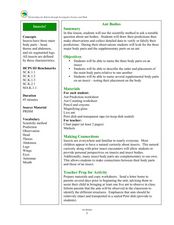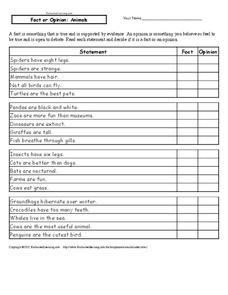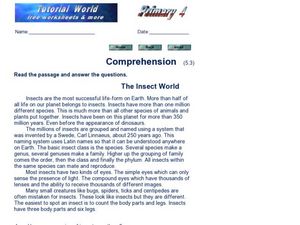Curated OER
Going Buggy? Scavenger Hunt
In this insects worksheet, students utilize the Internet to access a specific website to locate the answers to five short answer questions involving insects.
Curated OER
Take an Ant to Lunch
Second graders construct a model of an ant, exemplifying that ants are insects. Students gather data create a pictograph chart to show ant food preferences. Also, 2nd graders access the Internet to explore ant eating habits.
Curated OER
Arthropods, Insects, Arachnids, and Crustaceans
In this biology worksheet, students read about arthropods and some of the different species that fit into this classification. They then answer 13 questions about what they just learned. The answers are on the last page of the packet.
Desert Discoveries
Amazing Arthropods
Arthropods are the stars of a fine science instructional activity. Learners look at the diversity, characteristics, adaptations, and important roles that these insects play in the Sonoran Desert environment. A terrific document called...
Curated OER
Bee and Wasp Identification
Students study the differences between honey bee, bumble bee, paper wasp, and yellow jackets. For this insect classification lesson, students study posters of various bees and wasps. Students read the story Holly Honey Bee Story....
Curated OER
Insects
Students, through books, videos, and readings, explore characteristics of insects. In groups, they choose an insect to research. Students discover their insect's diet, how they move, and where they live. Afterwards, they use the facts...
Curated OER
Six Insect Legs
Learners observe and discuss the sun's position in the sky. They explore the number six, read various number books, and create the number six page for a counting book.
Curated OER
Ant Bodies
Learners name the three parts that comprise an insect body. In this ant lesson, students make connections regarding the curiosity of insects as it touches upon the learners' personal perspectives. Students then observe ants in class and...
Curated OER
Fact or Opinion: Animals
How many legs do spiders have? Is that an opinion, or is it a fact? Complete a worksheet with four sets of five questions about different animals and their attributes, noting whether each statement is a fact or an opinion.
Roland Park Country School
Butterfly or Moth?
What is the main difference between a moth and a butterfly? Butterflies have club-shaped antennae, while moths have a feather-like antennae. But what else differentiates these beautiful insects? The presentation in the resource provides...
Curated OER
Tables
Can you read this table? Learners begin to comprehend data analysis through examining two simple tables and answering comprehension questions. The first gives characteristics about three animals in yes-or-no format (i.e. "eats insects,"...
abcteach
German Vocabulary Crossword Puzzles
What animals says meow, and which creature has eight legs? Test your German language learners' knowledge of animals with a quick crossword puzzle. Also included are eleven additional crossword puzzles with topics that range from food to...
Curated OER
Termite Biology
Learners explore the physical characteristics, distribution and habitat of termites. The lesson focuses on the termite as a social creature contrary to most other insects.
Curated OER
Investigating Crickets and Their Body Parts
Second graders investigate the body of a cricket. In this biology lesson students use tools to gain information about the insect the cricket. Students observe and identify features and describe how these features help the cricket live in...
Curated OER
Macroinvertebrate Mix and Match
Students are introduced to macroinvertebrates (primarily insects), the major segments of aquatic insects (the head, thorax and abdomen) and also differentiate between larval, nymph and adult stages. They investigate the head, thorax and...
Curated OER
Diversity of Arthropods
In this arthropods worksheet, high schoolers will review the characteristics of the different types of arthropods including spiders, ticks, crustaceans, millipedes, and insects. Students will also understand the difference between...
Curated OER
Types of Legs
Students identify the characteristics of the legs of arthropods as well as how they are used. They compare and contrast the legs of various types of bugs in the arthropod family. A comparison worksheet is included in with this lesson.
Curated OER
Reading Comprehension: The Insect World
In this comprehension worksheet, students read a non-fiction passage titled, "The Insect World" and complete 5 short answer questions.
Curated OER
Insect Communication and Harmful Insects
Seventh graders use children's literature in order to create an interesting context for the lesson. The concept of insect communication is investigated in order for students to form educated hypothesis guesses.
Curated OER
Minibeasts: What Sort is It?
In this insect related worksheet, students research and describe a variety of insects to see if they have several legs or a large foot. Students then decide what type of insects they are dealing with.
Curated OER
Bug Detective
What happens when a living thing dies? After reading a paragraph of background knowledge on the life cycle of bugs, third and fourth graders work through four clues to figure out which bug is which. When they finish, they can study the...
Curated OER
Spider Watching
Spiders are creepy, crawly - and interesting! Young entomologists learn about parts of a spider's body, their habitats, ways spiders catch their prey, and what they most like to eat. Some excellent art activities are included in the plan...
Curated OER
Name that animal
A great way to classify organisms, is by counting the number of legs it has or how it moves. Little ones count the legs on five different creatures, then match the leg count to the proper animal name. Tip: Have them come up with other...
Curated OER
"Ladybugs and Grasshoppers"
Learners paricipate in number of activities related to ladybugs and grasshoppers.

























